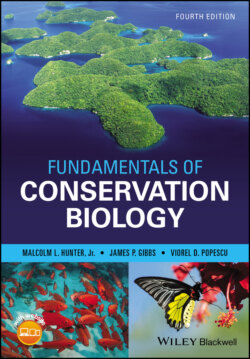Читать книгу Fundamentals of Conservation Biology - Malcolm L. Hunter Jr. - Страница 73
What Is an Ecosystem?
ОглавлениеIt is easy to define an ecosystem conceptually. It is a group of interacting organisms (usually called a community) and the physical environment they inhabit. It is much harder to delineate ecosystems in the real world – to decide where one ecosystem ends and another begins – because the web of interactions does not have clean breaks (Fig. 4.1). Most ecologists would say that a forest and an adjacent lake are different ecosystems because the assemblages of organisms inhabiting them are almost completely different and have relatively few direct interactions. This said, there are some interactions across the shoreline. Frogs leave the forest to lay their eggs in the lake and later small frogs hop into the forest. Wind moves huge numbers of autumn leaves into the lake, where they decompose. A bear visits the lake shore to catch fish and later defecates those digested fish back in the forest. These interactions in aggregate can be quite important. Conversely, many ecologists would say that a young oak forest and an adjacent old oak forest are the same ecosystem even though a fair number of their species would be different, as would some key ecological processes such as decomposition and water cycling. Separating two adjacent ecosystems is particularly difficult when the edge between them, often called an ecotone, is a gradual transition zone. For example, on the side of a mountain, ecosystems change continuously in response to the climate gradient that parallels elevation, and it is quite arbitrary to draw lines among them.
Figure 4.1 Deciding where one ecosystem begins and another ends is a complex task because the web of ecological interactions does not have clean breaks. In this example, distinguishing between the forest ecosystem and the lake ecosystem may be relatively easy, but is the young forest on the left a different ecosystem from the older forest on the right?
Distinguishing ecosystems is also difficult because ecologists think about ecosystems at a variety of spatial scales. A pool of water that collects in a hole in an old tree and is home to some algae and invertebrates can be considered an ecosystem. At the other extreme, ecosystems are sometimes defined on the basis of the movements of wide‐ranging animals. When biologists speak of the Serengeti Ecosystem they are referring to an area of almost 27,000 km2 defined in large part by the habitat needs of a migratory wildebeest population (Rentsch and Packer 2015). At the largest known scale, the Earth’s entire biosphere can be considered an ecosystem.
The key thing to understand is that the term “ecosystem” is a conceptual tool that makes it easier for us to organize our understanding about ecological interactions and to communicate about it. For the purposes of this book we can think of ecosystems at a spatial scale that is easy to detect from an airplane, typically from a fraction of a hectare to a few hundred hectares. We can draw the boundaries between adjacent ecosystems where they will separate distinct sets of species. Conservationists then give priority to maintaining examples of the different types of ecosystems thus delineated; we cannot realistically expect to protect every individual ecosystem.
